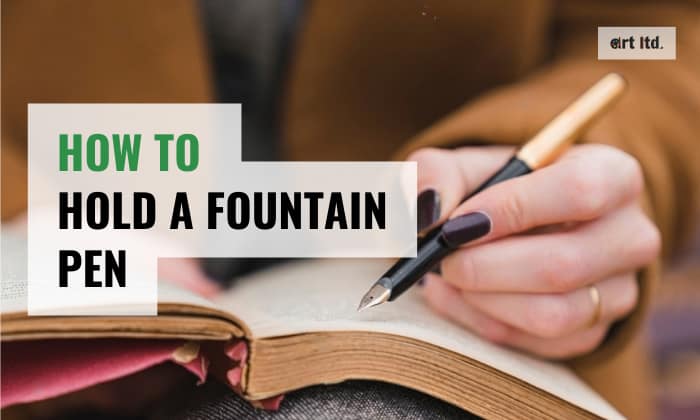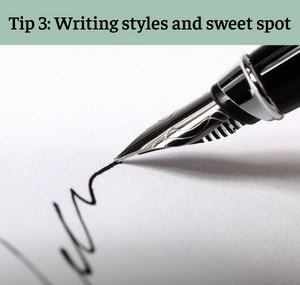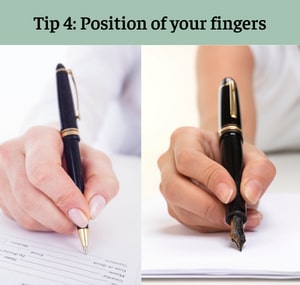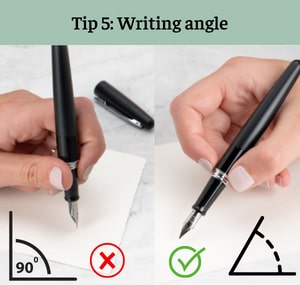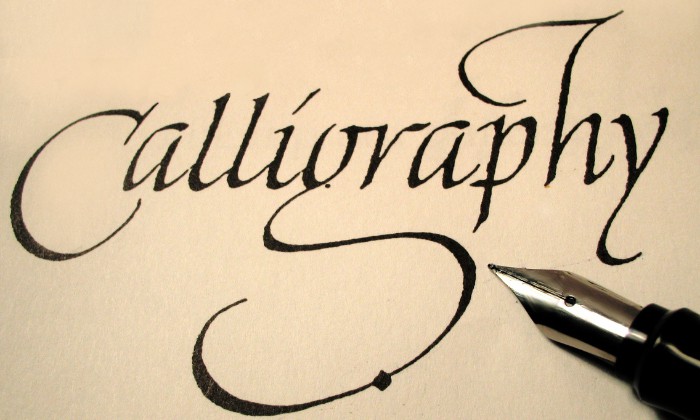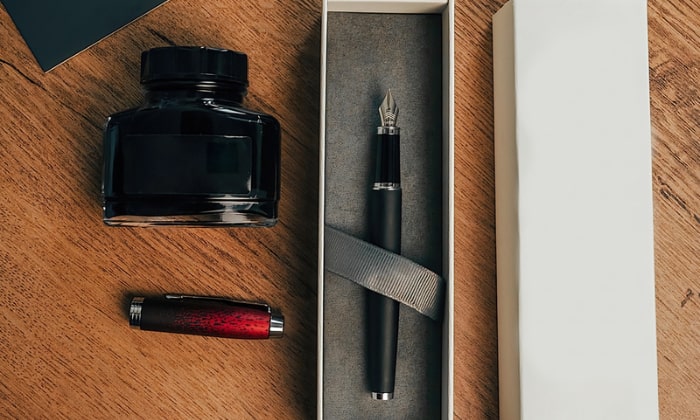When it comes to using fountain pens, how you position your grip with the help of your fingers could make all the difference in having a smooth and enjoyable writing experience.
Finding the right fountain pen grip will not only make your handwriting better but will also prevent hand cramps or fatigue when you need to write for longer periods.
In this article, we will teach you how to hold a fountain pen and help you find the perfect grip for this unique tool according to your writing style.
Table of Contents
Steps to Hold a Fountain Pen Correctly
1. Find your balance
The best way to find your balance is to get a fountain pen that matches the size of your hands and make sure you are comfortable with it. For example, women generally have smaller hands, so they tend to be more comfortable with smaller and lighter pens.
In addition, if you prefer your cap posted, keeping the clip of the cap in line with the nib can also provide additional balance.
2. Finger positioning
The most proper way to hold a pen when writing is using the tripod position.
You can do this by positioning the fountain pen between your thumb and your index finger in a pinch position while letting the middle finger support the weight of the pen and the remaining fingers can rest at an angle.
However, the best way to optimize the tripod position is to grip the pen with three fingers. Place the thumb and index finger on top of the pen and the middle finger on its underside. This will prepare you to get a good writing angle.
3. Check if you are holding it at the correct angle
When you write with a fountain pen, you will know right away if you are not at the right angle.
This is when your fountain pen starts to get scratchy and seems to be out of ink when in fact it’s new or freshly refilled.
The perfect writing angle should be not less than 45 degrees and not more than 55 degrees. At this angle, you get a steady ink flow for a smoother writing experience.
Other Tips When Holding a Fountain Pen
1. Posted and unposted
You have the option to have your fountain pens cap posted or unposted. Posting the cap can increase the pen weight and height. Some find this helpful in achieving a good balance, and securing the cap on post will likewise lessen your chances of losing them.
On the contrary, frequent posting can also lead to unwanted marks and posting rings that can ruin your supposed-to-be spotless fountain pens.
Moreover, there are different types of fountain pen caps, and not all fountain pens are designed with stackable caps.
2. Left-handed writing
It’s a common misconception that fountain pens are hardly workable for left-handed persons, and smudging the ink is a sure thing.
But that is not quite the case. The secret to the success of using fountain pens for lefties depends on the writing style or how you hold your pen.
For example, if you are an underwriter, this writing style does not pose a critical issue or smudging as your hands and fingers are positioned right below your writing. This allows you to have more freedom in choosing your ink and nib type.
However, if you are an overwriter or a side writer, your hand will mostly go over your writing. In this case, you need ink that dries quickly like Noodler’s ink. You can also pair that with a finer nib that releases less ink as you write.
3. Writing styles and sweet spot
The sweet spot is the most efficient position where part of the very tip of the fountain pen nib touches the paper and gives you that flawless and steady ink flow.
Depending on the pen, that sweet spot should be attained if you position your pen anywhere between 40° to 55° from the writing surface.
You’ll know that you are out of the sweet spot if you experience disjointed lines and scratchiness as you push down your pen.
You can find your pen’s sweet spot by practicing holding fountain pen while incorporating this angle into your writing style.
4. Position of your fingers
How you position your fingers is a crucial part of finding comfort and smoothness when you use fountain pen, especially for beginners.
Using a fountain pen requires you to position your fingers slightly above that grip area to get the ink flowing.
While you might be used to positioning your fingers close to the tip with other writing utensils, with fountain pens, that position will probably stir you away from the sweet spot.
5. Writing angle
Notice that we keep emphasizing the writing angle. That is simply because this is your ticket to getting into the sweet spot that is 40° to 55°.
The process of finding the sweet spot or the right writing angle will also help you understand why you need to hold the pen correctly.
The Importance of Holding the Pen in the Right Way
Holding the pen properly gives you the following benefits.
- Getting a consistent ink flow.
- It provides comfort and reduces hand cramps or fatigue.
- It helps you develop techniques for good handwriting.
Tips for Writing Movements
- Write with your bigger muscles. Instead of using your fingers to control your fountain pen, move with your forearms and wrist.
- Do not write or move too fast; write at a slower tempo.
- Move with relaxed fingers.
- Watch your angle and avoid rotating your pen.
- Avoid bending your elbows, and you’ll get less tense hands.
How to Write Calligraphy With Fountain Pens
- Choose an appropriate nib, preferably a broad nib that is perfect for italic writing.
- Make sure your reservoir has enough ink to avoid being cut out in the middle. Refill if needed.
- You can start using the draft and trace method, where you use a pencil to draw a guide that you can follow using your fountain pen.
- Keep practicing until you get used to it and do not need to draft anymore.
If you don’t want the draft and trace method, check out this video about writing calligraphy using fountain pens directly.
Additional Tips in Using Fountain Pens According to Your Writing Style or Penmanship
- If you prefer your penmanship to be small, go for a fine or extra-fine nib.
- If you write with larger strokes, try using a medium or broad nib.
- For lefties, aside from using a fine nib and quick-drying ink, opt for highly absorbent paper.
- Look for other inspirations and explore other nib types:
- Flexible nibs are your best bet for cursive writing.
- Stub nibs are great for everyday writing.
- Pointed nibs are good for sketching.
- Relax! You do not really need to put much pressure on paper, except when you are dealing with flexible nibs.
After Care
Fountain pens can last a lifetime if they are well-maintained. Unlike ordinary pens, they need a little extra TLC from time to time. Here are some tips on how to take care of your fountain pens.
- Check and clean them every other month or once a month if you can.
- Always keep your caps closed when not in use.
- Practice cleaning your nib after use; you can quickly do this by removing the cartridge and flushing it with water. Do not forget to dry it after washing.
- Do not store your fountain pens upside down.
- Store your fountain pens in their original box or case in their idle time.
Conclusion
Learning how to hold a fountain pen is fun but might not be that easy. However, we do hope that this guide and all the tips mentioned will help you through your journey in exploring your fountain pen.
Fountain pens can be intimidating to use at first, but you will find your sweet spot as long as you keep practicing what you have learned.
Do note that this is just a guide. You can always add your own preference as you gently unfold the best way to hold your fountain pens and get the most out of this experience.

Art has always been a part of my life; it influences my upbringing and later my career choice. For me, it is always a part of my parenting technique. So for whichever purpose that you come to art, you can start here with us.
